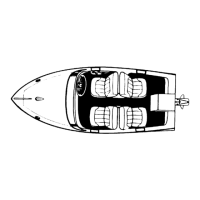4A-16 - STARTING SYSTEM 90-823225--1 1096
Positive Current Flow
This is a general description of the positive current
flow, from the battery and through the system until the
starter motor cranks.
• Battery to the solenoid switch (on starter)
(RED battery cable).
• Solenoid switch to circuit breaker (RED).
• Circuit breaker to wire junction (RED-PUR).
• Wire junction to wiring harness plug
(RED-PUR) terminal 6.
• Wiring harness plug to 20 amp fuse
(RED-PUR).
• 20 amp fuse to ignition switch terminal I
(RED-PUR). At this point ignition switch is
turned to START.
• Ignition switch terminal B to terminal S.
• Ignition switch terminal S to neutral start
switch (YEL-RED). NEUTRAL START SWITCH
MUST BE AT NEUTRAL POSITION.
• Neutral start switch to wiring harness plug
terminal 7 (YEL-RED).
• Wiring harness plug to starter solenoid (small
terminal) (YEL-RED). Also ensure that black
(small terminal) wire is grounded.
• Starter solenoid is now “closed,” completing
circuit between large terminal (RED-PUR) and
other large terminal (YEL-RED), causing
starter motor to crank.
Description
The Permanent Magnet Gear Reduction (PG200
and PG250) starter motors feature small permanent
magnets mounted inside the field frame (NOTE: The
actual configuration of these magnets differs be-
tween the PG200, PG250 and PG260; the field
frames with permanent magnets are not inter-
changeable. Otherwise, the units are similar.) These
magnets take the place of current-carrying field coils
mounted on iron pole pieces. Internal gear reduction,
approximately 4 to 1, through planetary gears results
in armature speeds in the 7000 RPM range. The ar-
mature and drive shaft are mounted on roller or ball
bearings in place of bushings. The solenoid switch,
plunger, return spring, and shift lever are permanent-
ly mounted in the drive housing.
!
CAUTION
The starter motor is designed to operate under
great overload and produce a high horsepower
for its size. It can do this only for a short time,
since considerable heat accumulates and can
cause serious damage. For this reason, the
cranking motor must never be used for more than
30 seconds at any one time. Cranking should not
be repeated without a pause of at least 2 minutes
to permit the heat to escape.

